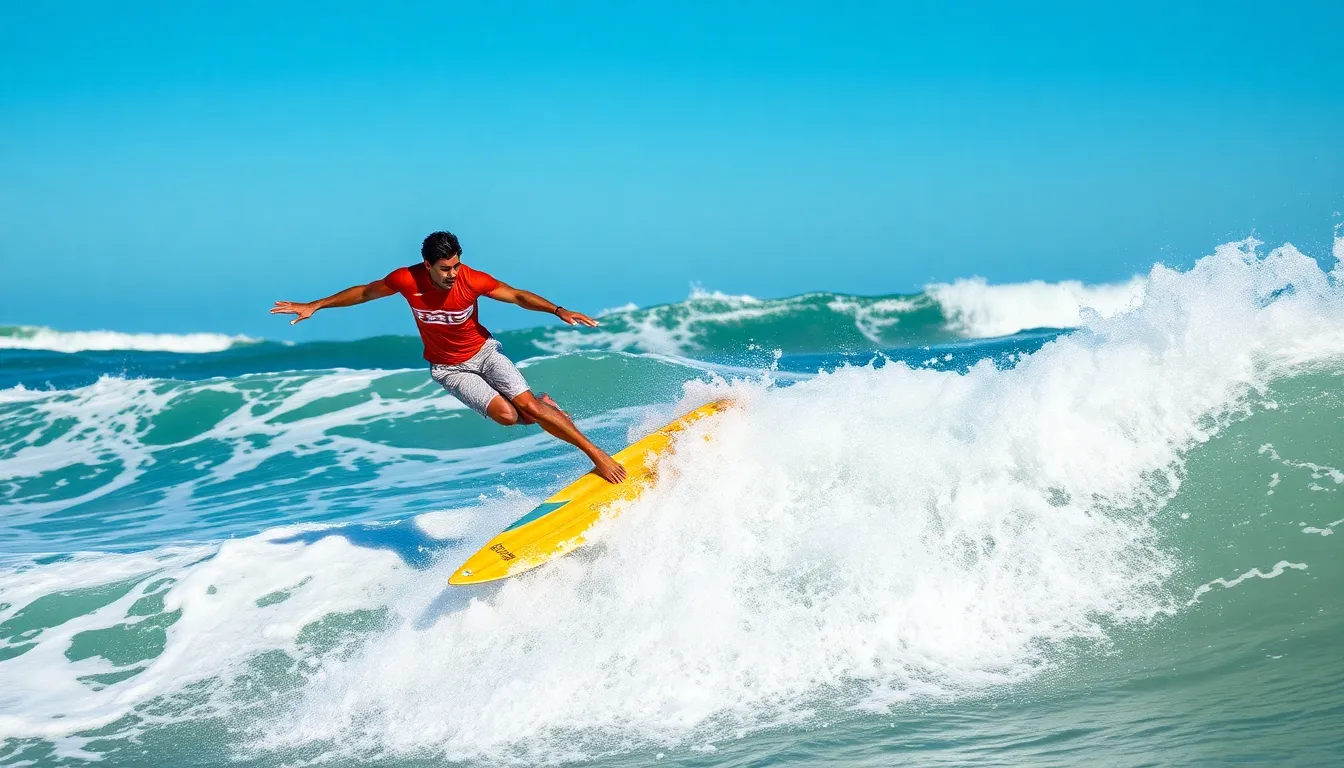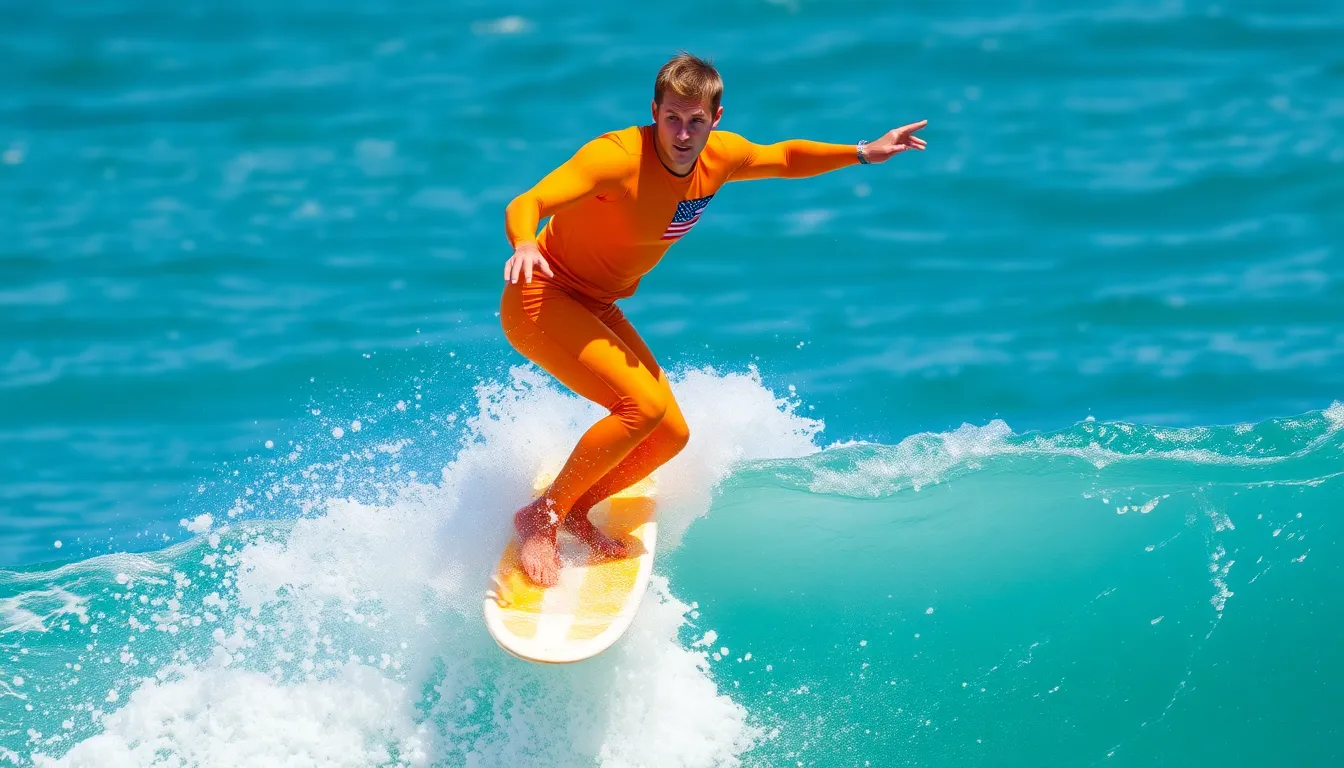Table of Contents
ToggleSurfing isn’t just about riding the waves; it’s an art form that demands skill, precision, and creativity. For seasoned surfers, mastering advanced maneuvers can elevate their performance and transform an ordinary session into an exhilarating experience. From aerials to barrel rolls, these techniques showcase a surfer’s ability to harness the power of the ocean while pushing the boundaries of what’s possible on a board.
As surfers progress, they often seek to refine their skills and add flair to their repertoire. Advanced maneuvers not only impress spectators but also enhance a surfer’s connection with the wave. Understanding the mechanics behind these techniques can lead to greater control and style, allowing surfers to express themselves uniquely. Whether it’s perfecting a cutback or attempting a radical air, the journey into advanced surfing is both challenging and rewarding.
Overview of Advanced Surfing Maneuvers
Advanced surfing maneuvers showcase a surfer’s skill and creativity. Mastery of techniques like aerials, barrel rolls, and cutbacks significantly enhances a surfer’s performance. Each maneuver requires an understanding of wave dynamics, balance, and timing.
Aerials
Aerials involve launching off the wave’s lip into the air. Surfers perform tricks during flight, showcasing agility and control. Key types of aerials include:
- Straight Air: Simple jump without rotation.
- 360s: Full rotation while airborne.
- Alley-Oop: Rotation performed while turning back toward the wave.
Barrel Rolls
Barrel rolls occur when surfers ride inside the hollow part of a breaking wave. Achieving this maneuver demands perfect positioning and timing. Essential components include:
- Entry: Finding the wave’s tunnel to maximize speed.
- Trim: Maintaining an optimal line to stay within the barrel.
- Exit: Timing the exit to return to the wave face smoothly.
Cutbacks
Cutbacks allow surfers to redirect their boards back toward the wave’s power source. This maneuver enhances connection with the wave’s face. Effective cutbacks involve:
- Edge Control: Manipulating the board’s rail for sharp turns.
- Body Positioning: Leaning forward to maintain speed and momentum.
- Re-engagement: Returning to the wave’s energy zone for sustained performance.
Other Notable Maneuvers
Surfers often incorporate additional maneuvers to diversify their skill set. These include:
- Floater: Riding the wave’s crest to maintain speed.
- Snap: Quick, sharp turns that generate velocity.
- Kick Out: Exiting a wave with flair, often during the end of a run.
By focusing on these advanced maneuvers, surfers can elevate their skills, impress onlookers, and deepen their connection with the ocean. Each technique offers unique challenges and rewards, making the pursuit of mastery both fulfilling and essential for progression in surfing.
Essential Skills for Mastery

Mastering advanced surfing maneuvers requires specific skills, particularly balance and coordination, along with wave selection expertise. These skills enhance a surfer’s ability to perform complex tricks and navigate challenging conditions.
Balance and Coordination
Balance and coordination form the foundation of effective surfing. Surfers maintain an upright posture, distributing weight evenly across the board. Key elements include:
- Core Strength: A strong core stabilizes the body while maneuvering.
- Foot Placement: Proper foot positioning ensures optimal control and responsiveness.
- Upper Body Movement: Effective arm and shoulder movements help maintain balance during turns and tricks.
- Flexibility: Increased flexibility aids in adjusting body positions quickly, enhancing maneuverability.
Surfers who consistently practice balance exercises, such as yoga or stability training, can enhance their performance and confidence.
Wave Selection
Effective wave selection significantly impacts the quality of surf experiences and performance. Surfers assess various factors to choose the best waves, including:
- Wave Size: Understanding wave height and power helps determine suitability for maneuvers.
- Wave Shape: Identifying peak formations allows surfers to position themselves for optimal rides.
- Breaking Points: Recognizing where waves break aids in predicting speed and direction.
- Tide and Wind Conditions: Awareness of tide patterns and wind influences can enhance surfing conditions.
Surfers capable of analyzing these factors can maximize their ride quality, create opportunities for advanced maneuvers, and enhance overall efficacy on the water.
Popular Advanced Surfing Maneuvers
Advanced surfing maneuvers showcase a surfer’s creativity and technical skill. Three popular categories of these maneuvers include air maneuvers, carving turns, and tube riding, each requiring specific techniques and conditions.
Air Maneuvers
Air maneuvers involve launching off the wave’s lip to perform tricks mid-air. Key types include:
- Straight Air: Surfer launches vertically from the wave, achieving height without rotations.
- 360s: Surfer performs a complete spin while airborne, landing back on the wave.
- Alley-Oops: Surfer jumps and rotates in the opposite direction from the wave while simultaneously performing a spin.
Successful execution relies on excellent timing, wave selection, and precise body control.
Carving Turns
Carving turns allow surfers to redirect their boards back toward the wave’s power source. Fundamental elements include:
- Edge Control: Surfers apply pressure on the rail to grip the wave face effectively.
- Body Positioning: Proper weight distribution enhances maneuverability and speed.
- Re-engagement: Surfers must time their turns to maximize energy and maintain speed by linking multiple turns.
Mastering carving turns elevates a surfer’s performance and creates a fluid, dynamic riding experience.
Tube Riding
Tube riding, or barrel riding, requires skill to navigate the hollow part of a breaking wave. Critical aspects include:
- Entry: Surfers need precision foot placement for a successful entry into the barrel.
- Trim: Maintaining the right speed inside the tube ensures smoother rides without slowing down.
- Exit: Timing the exit is crucial; surfers must position themselves correctly to emerge safely from the barrel.
Having the ability to tube ride exemplifies advanced skill and enhances the thrill of surfing, solidifying the surfer’s connection with the wave.
Techniques for Improvement
Surfers seeking to enhance their advanced maneuvers can focus on practice drills and seek coaching and feedback. These strategies can significantly impact their skills and overall performance.
Practice Drills
Drills are essential for improving specific surfing techniques. Surfers can implement the following drills to hone their skills:
- Aerial Progression: Practice launching off small waves to build comfort and control. Gradually increase the height and complexity of jumps, focusing on landing safely.
- Cutback Focus: Set up a buoy in the water to simulate the wave’s power source. Practice turning back towards the buoy while maintaining speed and balance.
- Tube Riding Simulation: Use a foam board in a small wave environment to practice positioning for barrel rides. Focus on timing the entry and exit from the tube.
- Balance Drills: Utilize a balance board or perform yoga to enhance stability. Integrate movements that mimic surfing postures to build core strength.
- Edge Control Exercises: Ride skateboards or surf on small waves to practice controlling the board’s edge during turns, enhancing responsiveness.
Coaching and Feedback
Receiving constructive coaching and feedback can accelerate skill development. Surfers should consider these approaches:
- Video Analysis: Record surf sessions to review performance. Analyze techniques and identify areas for improvement.
- One-on-One Coaching: Work with experienced instructors who can provide tailored feedback and guidance on specific maneuvers.
- Peer Sessions: Surf with more advanced friends or mentors who can offer tips and direct observations in real-time.
- Skill Workshops: Attend workshops that focus on advanced techniques, allowing surfers to learn from experts and practice alongside peers.
- Goal Setting: Set specific, measurable goals for each surf session. Review progress regularly to stay focused on improvement areas.
By integrating these techniques for improvement, surfers can effectively enhance their advanced maneuver skills, leading to a more dynamic surfing experience.
Safety Considerations
Surfers must prioritize safety when performing advanced maneuvers. Understanding the risks associated with surfing, especially with aerials and tube riding, proves crucial for preventing injuries and ensuring a positive experience.
- Waves and Conditions: Assess wave size, swell direction, and tide before entering the water. Strong currents and big swells increase the difficulty of advanced maneuvers, creating risks of wipeouts and collisions.
- Proper Equipment: Use a suitable surfboard for specific maneuvers. Boards vary in design for surf styles, impacting performance and safety. Consider a board with appropriate dimensions, rocker, and fin setup based on skill level and wave conditions.
- Body Fitness: Maintain physical fitness to endure the demands of surfing. Engaging in strength and conditioning workouts builds stamina and reduces the risk of injury. Flexibility exercises, such as yoga, enhance movement and recovery.
- Surfing Etiquette: Follow established surfing etiquette to promote safety in crowded waters. Communicate intentions to fellow surfers, yield to those already riding waves, and respect local rules, which cultivates a safer environment for everyone.
- Awareness: Stay alert to surroundings while surfing. Be aware of other surfers, swimmers, and obstacles like rocks or reefs. Recognizing potential hazards can prevent accidents.
Surfers who integrate these safety considerations into practice routines reduce risks while enhancing performance during advanced maneuvers.
Mastering advanced surfing maneuvers opens up a world of creativity and expression on the waves. By honing skills like aerials, cutbacks, and barrel rolls, surfers not only enhance their performance but also deepen their connection with the ocean. The journey toward mastering these techniques is filled with challenges and rewards, encouraging surfers to push their limits.
Incorporating practice drills and seeking constructive feedback can lead to significant improvements. Prioritizing safety ensures that the pursuit of these maneuvers remains enjoyable and injury-free. Ultimately, the commitment to mastering advanced skills transforms surfing into an exhilarating art form that celebrates both personal growth and the thrill of riding waves.




